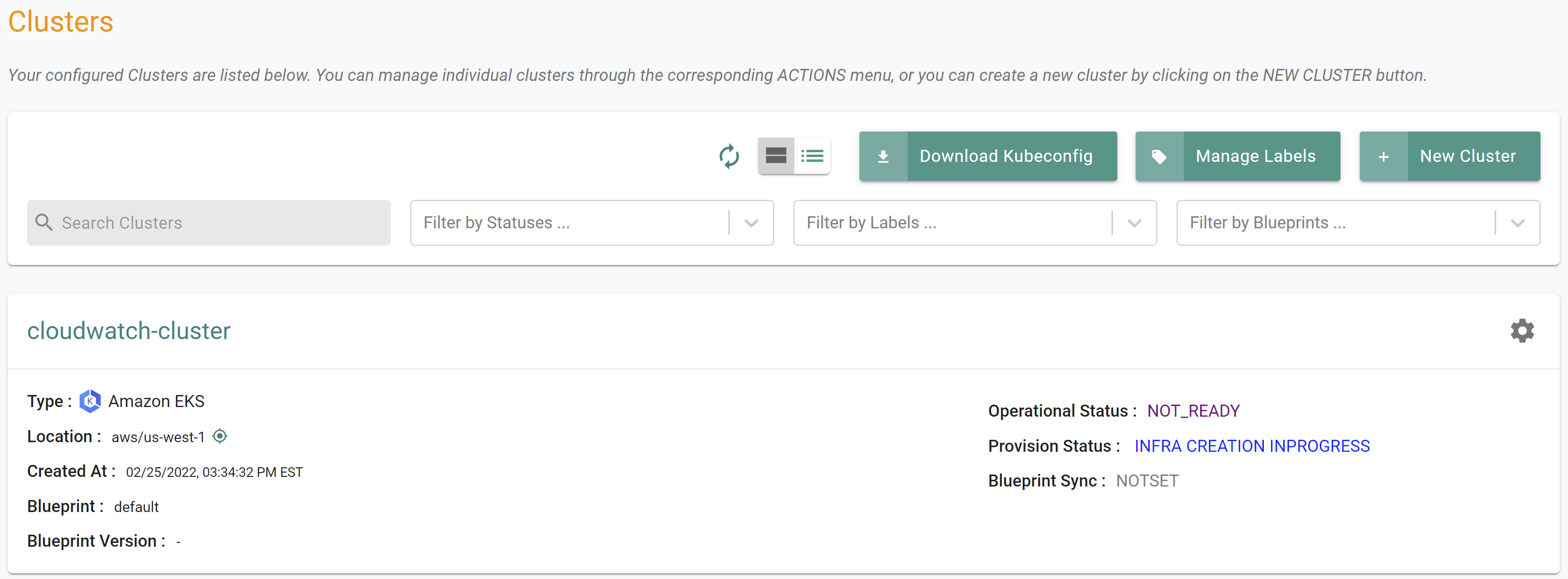Part 2: Provision
What Will You Do¶
In this part of the self-paced exercise, you will provision an Amazon EKS cluster based on a declarative cluster specification.
Important
Users that already have a managed EKS cluster in a project in their Org can skip this part completely.
Step 1: Cluster Spec¶
- Open Terminal (on macOS/Linux) or Command Prompt (Windows) and navigate to the folder where you forked the Git repository
- Navigate to the folder "
/getstarted/cloudwatch/cluster"
The "cloudwatch-eks-cluster.yaml" file contains the declarative specification for our Amazon EKS Cluster.
Cluster Details¶
The following items may need to be updated/customized if you made changes to these or used alternate values.
- cluster name: "cloudwatch-cluster"
- project: "defaultproject"
- cloud provider: "aws-cloud-credential"
- name: "cloudwatch-cluster"
- region: "us-west-2"
apiVersion: infra.k8smgmt.io/v3
kind: Cluster
metadata:
name: cloudwatch-cluster
project: defaultproject
spec:
blueprintConfig:
name: default
version: latest
cloudCredentials: aws-cloud-credential
config:
addons:
- name: kube-proxy
version: latest
- name: vpc-cni
version: latest
- name: coredns
version: latest
iam:
withOIDC: true
managedNodeGroups:
- amiFamily: AmazonLinux2
desiredCapacity: 2
instanceType: t3.large
maxSize: 2
minSize: 1
name: ng-1
metadata:
name: cloudwatch-cluster
region: us-west-2
tags:
email: user@rafay.co
env: qa
version: latest
network:
cni:
name: aws-cni
vpc:
autoAllocateIPv6: false
clusterEndpoints:
privateAccess: true
publicAccess: false
cidr: 192.168.0.0/16
type: aws-eks
Step 2: Provision Cluster¶
- Type the command below to provision the EKS cluster
rctl apply -f cloudwatch-eks-cluster.yaml
If there are no errors, you will be presented with a "Task ID" that you can use to check progress/status. Note that this step requires creation of infrastructure in your AWS account and can take ~20-30 minutes to complete.
{
"taskset_id": "empr728",
"operations": [
{
"operation": "NodegroupCreation",
"resource_name": "ng-1",
"status": "PROVISION_TASK_STATUS_PENDING"
},
{
"operation": "ClusterCreation",
"resource_name": "cloudwatch-cluster",
"status": "PROVISION_TASK_STATUS_PENDING"
}
],
"comments": "The status of the operations can be fetched using taskset_id",
"status": "PROVISION_TASKSET_STATUS_PENDING"
}
- Navigate to the "defaultproject" project in your Org
- Click on Infrastructure -> Clusters. You should see something like the following
- Click on the cluster name to monitor progress
Step 3: Verify Cluster¶
Once provisioning is complete, you should see a healthy cluster in the web console
- Click on the kubectl link and type the following command
kubectl get nodes
You should see something like the following
NAME STATUS ROLES AGE VERSION
ip-192-168-36-4.us-west-2.compute.internal Ready <none> 22m v1.21.5-eks-bc4871b
ip-192-168-80-129.us-west-2.compute.internal Ready <none> 22m v1.21.5-eks-bc4871b
Recap¶
As of this step, you have created an EKS cluster with the default cluster blueprint. In the next section, you will create a custom cluster blueprint with the Amazon Cloudwatch agent as an addon.


